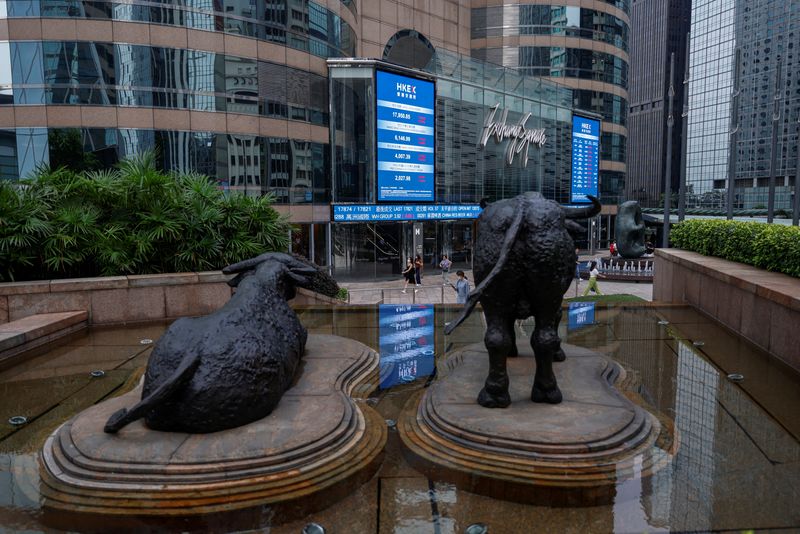A look at the day ahead in U.S. and global markets from Mike Dolan
World markets painted a messy picture on Tuesday, with recently pumped-up crude oil prices retreating sharply and disappointment surrounding China's economic stimulus already setting in - knocking Hong Kong shares back almost 10%.
The return of mainland Chinese markets after a week's holiday there did see the CSI300 index play catch-up with another jump of about 6%. But the Hang Seng, which had remained open for much of the week and rallied significantly during that time, turned tail.
Chinese officials said they were fully confident of achieving this year's 5% GDP growth target. But there were no stronger fiscal measures announced yet to accompany the wave of monetary easing from two weeks ago - disappointing investors who had banked on more support.
With mounting tensions surrounding a potential trade war between Europe and China following last week's European Union decision to back tariffs on Chinese electric vehicle imports, the outlook becomes edgier in both regions. And that is before you consider what happens after the U.S. election.
European spirits makers and luxury goods firms fell sharply as China imposed temporary anti-dumping measures on brandy imports from the European Union on Tuesday, hitting brands from Hennessy to Remy Martin, after the 27-member bloc voted last week for tariffs on Chinese-made EVs.
China also said it was studying measures such as raising tariffs on imported large-displacement fuel vehicles.
Europe's STOXX was down almost 1% early on Tuesday, even though Wall Street futures recovered ground after Monday's pullback in New York.
Although Middle East anxieties remain high, oil prices retreated sharply again as an Israeli response to last week's Iranian rocket attack was still awaited - even as the conflict on the ground in Lebanon ratcheted up on Tuesday.
U.S. crude prices fell back to $75 per barrel - sustaining annual losses of close to 9% - and reflecting how recent gains may have been as much to do with a potential Chinese demand boost as supply worries from Iran.
In the background, however, Hurricane Milton intensified into a Category 5 storm on its way to Florida after forcing at least one oil and gas platform in the Gulf of Mexico to shut on Monday.
Despite a small bounce in U.S. stock futures on Tuesday, perhaps the most revealing reflection of markets this week has been a rise in implied volatility captured by the VIX index to its highest in a month.
That tick higher is itself partly related to the fact that the 30-day contract now covers the Nov. 3 election, with the third-quarter corporate earnings season due to kick off this week.
The real volatility this week has been in rates markets, however, with the MOVE index of Treasury volatility hitting its highest since the first week in January.
The shock of such a robust U.S. employment report last week saw seismic shifts in Federal Reserve rates speculation - taking out at least one projected Fed rate cut from next year and even sowing doubts about whether there will be second cut as soon as next month.
Adding to the pressure on Treasuries was a focus on post-election fiscal plans of both candidates, with Republican Donald Trump's policy outlines estimated to have twice the negative effect on the already bloated budget deficit than those of Democrat Kamala Harris.
Opinion polls and betting markets have the two virtually neck and neck with less than a month to go.
With some $72 billion of 3-year Treasury notes under the hammer later, the rates picture calmed a touch first thing today. Ten-year yields clung on to 4%, but the 2-10-year yield curve gap flipped back positive after its first inversion in almost a month on Monday.
The dollar slipped a touch but held the bulk of last week's gains - the biggest weekly rise in two years.
Fed officials indicated that if they get the green light on inflation they are prepared to keep easing to support the clearly still strong labor market. And that ups the ante for Thursday's September consumer price inflation report.
"The labor market remains resilient, but I support a balanced approach to the FOMC's dual mandate so we can continue making progress on inflation while avoiding an undesirable slowdown in employment growth," Fed Governor Adriana Kugler said on Tuesday.
Kugler added that there were several metrics suggesting that the jobs market was cooling to pre-pandemic levels but the Fed does not want to cause "undue" pain.
New York Fed boss John Williams echoed that view in comments to the Financial Times and underlined standing Fed projections as the best guess on how things unfold.
"If you look at the SEP (Summary of Economic Predictions) projections that capture the totality of the views, it's a very good base case with an economy that's continuing to grow and inflation coming back to 2 per cent."
Key developments that should provide more direction to U.S. markets later on Tuesday:
* US August international trade balance, Canada August trade balance,
* Federal Reserve Vice Chair Philip Jefferson, Fed Board Governor Adriana Kugler, Boston Fed President Susan Collins, Atlanta Fed chief Raphael Bostic all speak
* European Union finance ministers ECOFIN meeting in Luxembourg, joined by European Central Bank Vice President Luis de Guindos

* US corporate earnings: PepsiCo (NASDAQ:PEP)
* US Treasury auctions $72 billion of 3-year notes
(By Mike Dolan, editing by Ed Osmond; mike.dolan@thomsonreuters.com)